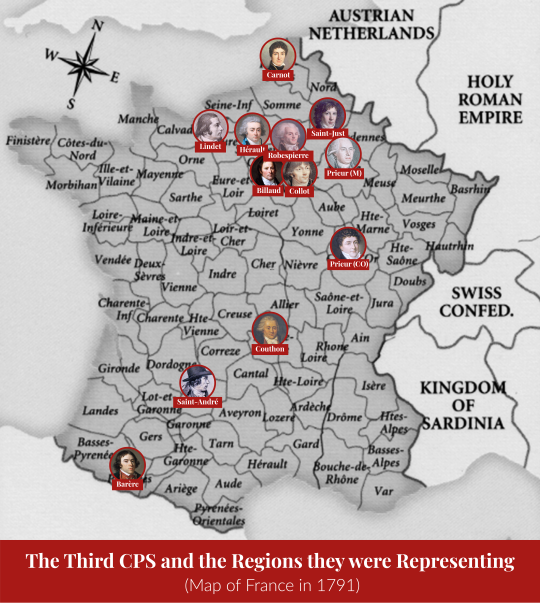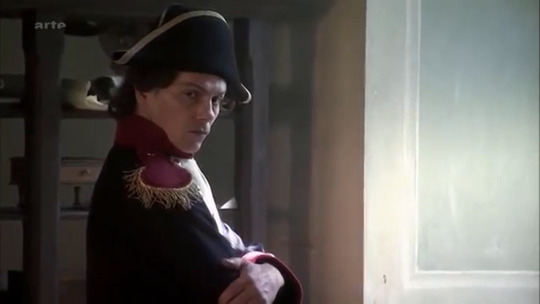#claude antoine prieur
Text

Carnot, Lindet, Prieur de la Côte-d'Or in a fragment of "Panorama de l'Histoire du siècle 1788-1889" by Alfred Stevens and Henri Gervex, Musée des Beaux-Arts de la ville de Paris.
Sources: 1, 2
References for the characters' names from Stevens, Gervex, Reinach "L'Histoire du Siècle", p. 36-37 (note: Prieur is wrongly listed as "de la Marne*)
#lazare carnot#robert lindet#claude antoine prieur#claude antoine prieur duvernois#lindet#prieur de la cote-d'or#frev#french revolution#art#frev art#prieur duvernois
101 notes
·
View notes
Text


Carnot and Prieur.
(I can't draw hands well now)
11 notes
·
View notes
Text
This site compiled their addresses here though Barère's page is missing (here are some of his addresses), Lindet's address is different than the one give here, and though some mail was sent to Couthon where Robespierre lived, I think he had another address too? (Hérault is also just not listed but the site is centered around Thermidor.)

Copy-pasted below for convenience. I added their birthdates and astrological signs (for those who care about that):
Jean-Baptiste Robert Lindet
Age : Né à Bernay (Eure), 48 ans en thermidor. [2 mai 1746 ♉]
Adresse : 68, rue de la Sourdière.
Métier : Avocat
Fonctions : Député de l’Eure, membre du Comité de salut public du 6 avril 1793 au 7 octobre 1794
Antoine Louis Léon de Saint-Just
Age: Né à Décize, 26 ans en Thermidor an II [25 août 1767 ♍]
Adresse: 3, rue Caumartin, 2ème étage (depuis mars 1794), à la même adresse que Thuillier. Il demeurait auparavant à l’hôtel des États-Unis, rue Gaillon.
Fonction(s): Député de l’Aisne à la Convention depuis le 5 septembre 1792, membre du Comité de Salut Public depuis le 10 juin 1793.
Georges-Auguste Couthon
Age : Né à Orcet, 38 ans en thermidor [22 décembre 1755 ♑]
Adresse : 366, rue Saint Honoré
Profession : Avocat
Fonction(s) : Elu député du Puy-de-Dôme à la Convention le 6 septembre 1792. Membre du Comité de salut public du 10 juin 1793 au 9 Thermidor an II.
André Jeanbon, dit JEAN BON SAINT-ANDRÉ
Age : Né à Montauban, 45 ans en thermidor [25 février 1749 ♓]
Adresse : 7 rue Gaillon
Profession : Marin, puis pasteur
Fonction(s) : Elu député du Lot à la Convention le 5 septembre 1792, membre du Comité de salut public depuis le 10 juin 1793. Fréquemment en mission pour superviser les opérations maritimes, il est absent de Paris le 9-Thermidor.
Pierre-Louis Prieur, dit PRIEUR de la MARNE
Age : Né à Sommesous (Marne), 37 ans en thermidor [1er août 1756 ♌]
Surnom : Appelé Prieur de la Marne (pour le différencier de Prieur de la Côte-d’Or)
Adresse : 11, rue Helvetius
Métier : Avocat
Fonction(s) : Député de la Marne à la Convention depuis le 3 septembre 1792, membre du Comité de salut public du 10 juillet 1793 au 13 thermidor an II (31 juillet 1794), puis à nouveau du 15 vendémiaire au 15 pluviôse an III (6 octobre 1794-3 février 1795).
Absent de Paris au moment du 9-Thermidor.
Maximilien Marie Isidore de Robespierre
Age : Né à Arras, 36 ans en thermidor. [6 mai 1758 ♉]
Adresse : 366 rue Saint-Honoré (numérotation actuelle : 398)
Métier : Avocat
Fonction(s) : Député de Paris à la Convention nationale depuis le 5 septembre 1792 ; membre du Comité de salut public depuis le 27 juillet 1793
Claude-Antoine Prieur-Duvernois, dit PRIEUR de la CÔTE-d'OR
Age : Né à Auxonne, 30 ans en thermidor [22 décembre 1763 ♑]
Surnom : Appelé Prieur de la Côte-d’Or (pour le différencier de Prieur de la Marne)
Adresse : 5, rue Caumartin
Profession : Ingénieur militaire
Fonction(s) : Elu député de la Côte-d’Or à la Convention le 5 septembre 1792. Membre du Comité de salut public du 14 août 1793 au 16 vendémiaire an III (7 octobre 1794).
Lazare Nicolas Marguerite Carnot
Age : Né à Nolay, 41 ans en thermidor. [13 mai 1753 ♉]
Adresse : 2 rue Florentin
Métier : Mathématicien, physicien, militaire
Fonction(s) : Elu député du Pas-de-Calais à la Convention nationale le 5 septembre 1792 ; membre du Comité de salut public depuis le 14 août 1793, il le quitte le 7 octobre 1794 mais y siège à nouveau un mois plus tard, jusqu’au 6 mars 1795.
Jacques-Nicolas Billaud, dit BILLAUD-VARENNE
Age : Né à La Rochelle, 38 ans en Thermidor an II [23 avril 1756 ♉]
Adresse : 40 rue Saint-André-des-Arts
Métier : Avocat
Fonction(s) : Député de Paris à la Convention depuis le 7 septembre 1792, membre du Comité de Salut Public depuis le 5 septembre 1793
Jean-Marie Collot, dit COLLOT d'HERBOIS
Age : Né à Paris, 45 ans en Thermidor an II [19 juin 1749 ♊]
Adresse : 4 rue Favart (3ème étage)
Métier : Acteur, directeur de théâtre
Fonction(s) : Elu député de Paris à la Convention le 6 septembre 1792, membre du Comité de Salut Public depuis le 5 septembre 1793.
#the csp#committee of public safety#comité de salut public#antoine saint just#maximilien robespierre#robert lindet#lazare carnot#claude antoine prieur#jacques nicolas billaud varenne#collot d'herbois#georges couthon#andré jeanbon saint andré#pierre louis prieur#prieur duvernois#prieur de la côte d'or#prieur de la marne#jeanbon saint-andré#bertrand barère
37 notes
·
View notes
Text

I am geographically challenged, and I really, really wanted a way to visualise what constituencies the members of the Third Committee of Public Safety ( July 1793 – July 1794) represented. So, this map was born.
Bertrand Barère: Hautes-Pyrénées
Jacques Billaud-Varenne: Paris
Lazare Carnot: Pas-de-Calais
Jean-Marie Collot: Paris
Georges Couthon: Puy-de-Dôme
Marie-Jean Hérault de Séchelles: Seine-et-Oise
Robert Lindet: Eure
Pierre-Louis Prieur de la Marne: Marne (hence the name…)
Claude-Antoine Prieur: Côte-d'Or (ditto)
Maximilien Robespierre: Paris
André Jeanbon Saint-André: Lot
Louis Antoine de Saint-Just: Aisne
PS: It’s fascinating and telling how many of them represented provinces in the north of France.
#frev#robespierre#french revolution#couthon#barere#collot#billaud varenne#herault#lazare carnot#saint just#saint-andre#Committee of Public Safety#priuer
83 notes
·
View notes
Text
LIBERAL committee of public safety:
Bertrand BaRED (like communism) de Vieuzac
Jacques-Nicolas BIllaud-Varenne
Carnot isn't here because I couldn't think of anything the Second Law of Thermodynamics disproved the LIBERAL Big Bang Theory
Jean-Marie COMMUNISM d'Herbois
Georges CouthONBINARY
Jeanbon SLAYnt-André
Jean-Baptiste Robert LGBTndet
Pierre Louis Prieur (Prieur de la MARX)
Claude Antoine PRONOUN-Duvernois
Maximilien de WOKEspierre
Louis Antoine de SOCIALISM
Marie-Jean SHE/HERault de Séchelles
27 notes
·
View notes
Text

An unexpected revelation.
In all honesty, not really that unexpected in itself, but I'm baffled by how easily wrong information can be spread. I've always wondered, indeed, how it was possible for him to be granted or have asked for the title of count given the feeling of "despise" between him and Napoléon.
The excerpt above comes from Gaffarel's biography (p. 349), Bouchard's one doesn't even mention such misunderstanding. According to the former, some of the earliest Prieur's biographers, whose work I happened to find here, stated that he was made comte de l'Empire without quoting a source and looking at the list of people receiving titles during the Napoleonic Era written by Campardon, Prieur's name is in fact missing.
39 notes
·
View notes
Text
Letter from Claude-Antoine Prieur to Louis XVI on the importance of having a unified metric system in France
[The letter is dated April 1790 and included a copy of Prieur's Mémoire sur la nécessité et les moyens de rendre uniformes, dans le royaume, toutes les mesures d'étendue et de pesanteur]
"Sire,
The reputation that your Majesty has gained through his passion for sciences and the protection with which he has constantly provided them inspired in me the desire to offer him a work I have done on the necessity and the means to bring all measures of France to uniformity.
I beg your Majesty to honour me for a moment of his attention, not much for some special merit concerning my work, but above all for the high importance of its content.
It is a great and beautiful idea, the one of giving to a great people a common and invariable measure, and, even better, to make it universal. Today, the difficulties related to the lack of precision in the procedures have been overcome; what is left is just a few prejudices relegated to the classes of ignorant people, of whom the triumphant voice of reason will dismiss the prestige.
France, England, the United States of America have addressed the matter not only in their own countries, but they are in open agreement to achieve an identical result.
Savants are rather convinced of the effectiveness of this operation for the advancement of science; but how much it will reveal itself useful in easing commercial relations, from the simplest exchanges, which people’s daily needs require, to the greatest speculations!
From this double perspective of science and commerce, the States of your Majesty maintain a distinguished position among civilised nations. After all, wisdom, moderation, in a word, all the virtues of your Majesty, suggest on his part an aspiring desire towards the noble glory of being included among the benefactors of humankind. May I be allowed to say that this is a fortunate occasion to add a new benefit to those that your subject already owe you: the reunion of your Majesty with other countries to procure the same measures would be a big improvement and a favourable wish for the happiness of the people; nothing is more appropriate to strengthen in them the bonds of fraternity and concord like the sweet influence of Philosophy.
Respect has set limits that I am not entitled to go beyond. Nevertheless I thought to let truth arrive to the ears of a prince, who, because of his greatness of spirit, has always proven himself worthy of listening. To touch the heart of your Majesty, it is undoubtedly sufficient to mention a useful purpose: it will be even more touched to know that the probity, of which the operation in question is significantly the custodian, will put an end to the activities and tricks of the scoundrels.
I have persuaded myself that my disinterested homages would not be unpleasant; I am, with the utmost respect, your Majesty’s most humble and obedient servant."
— from G. Bouchard, Prieur de la Cote-d'Or, Pièces Annexées, p. 458 - 459
#if you are wondering Louis ghosted him#<- this is why Prieur became a regicide /s#louis xvi#claude antoine prieur#prieur de la cote-d'or#claude antoine prieur duvernois#metric system#prieur duvernois#history of science#frev#my translations
26 notes
·
View notes
Text

POV: you are at Lavoisier's place and forced to hear the reactionary nonsense of your colleagues from the Weights and Measures Commission.
#claude antoine prieur#i made this in 10/15 min so forgive the poor quality#i felt the urge to draw even though I have more important stuff to do#Prieur one day I will learn how to properly draw your hair but apparently that day is not today#my art#fun#frev#frev art#art
24 notes
·
View notes
Text
Prieur on the implementation of the decimal scale in the metric system
The key point, in which Prieur's proposal, aimed to reform the French metric system, differentiates itself from the others, lies in the detailed implementation of the decimal scale for all kind of measures. This is why I thought appropriate to share the following excerpt, taken directly from his work. Its content might sound obvious for many of us, but it's important to remember that, in the 18th century, the scale commonly used in France was the duodecimal one. Prieur was among the scholars of the time to have relised the great advantages that the decimal subdivision would have brought in the fields of calculation and arithmetic, by making the former more straightforward in general and the latter more accessible to everyone, especially to those, who didn't receive an education.
Below, under the cut, I also added the transcribed version by Isabelle Dutailly of Prieur's measures conversion table between the standards used during the Ancien Régime in Paris and the new ones, he proposed to use. It gives a general idea about both the tremendous amount of units present just in the capital and how close Prieur's subdivision of measures is compared to our current one.
"[...]Our pied national will be divided into ten pouches, each pouche in ten lignes, each ligne in ten points or primes, so that it will be possible to write each subspecies [of measure] as decimals of the main unit. This method of division is the most proper that we can accept, since it is in accordance with the rules of our numeration and, if it were applied to all the various kind of measures, the study of arithmetic would become much easier and, as a result, more widely practiced. Someone might say that diving by twelve would be convenient when considering the 1/3, 1/4 and their submultiples: this is undeniable. It is also certain that the duodecimal scale could have been used instead of the decimal one for our numeration, but such a change would currently be impractical . On the other hand, the decimal system reveals itself to be convenient for people, who do not know how to write, since it would allow them to represent each ten through their fingers, therefore each hand would be equal to one half of ten, making the count of five parts easier. The introduction of the decimals in all the measures is beneficial in making calculation easier, in that more complex multiplications and divisions are converted to operations similar to those of whole numbers; in that the reduction of each subspecies, from one to another, happens through the simple shift of the decimal point and finally, in that it would allow to increase or decrease the precision of an operation according to our needs. In the majority of cases relative to calculations of our length measurements, there is no need for this operation to go beyond the thousandth, and often the hundredth too, of the main unit."
— Claude-Antoine Prieur, Mémoire sur la nécessité et les moyens de rendre uniformes, dans le royaume, toutes les mesures d'étendue et de pesanteur (1790), p.15-16.
Note: Emphases in italics are mine, moreover I didn't translate the units into English, because their corresponding value in said language wouldn't match with the French one, so I believed it wasn't wise.
"Table of comparison between the old units of weights and length used in the city of Paris and the new national ones, which are supposed to replace the former"


Source for the original table.Source for the transcribed version.
#claude antoine prieur#prieur de la cote d'or#claude antoine prieur duvernois#metric system#history of science#frev#my posts#prieur duvernois
20 notes
·
View notes
Text
I'm finally watching Un mètre pour mésurer le monde. I'm 6 minutes in and I'm already rolling my eyes.. But surprisingly in a positive way, similar to whenever I watch the Terror BBC Doc.
I'm literally just waiting for this meany to show up again :3

By the way, why would Prieur have wanted to use the Parisian metric unit as standard in 1792 when just one year earlier he had already opted for the Earth meridian arc??
I'm confused.🤨
Also from the very beginning of this doc he's explicitly presented as one of the villains L M A O
#claude antoine prieur#prieur de la cote d'or#prieur duvernois#frev#the holy meter#un mètre pour mésurer le monde
45 notes
·
View notes
Text
Prieur de la Côte-d'Or in a nutshell:

Forgive me, Claude-Antoine >.>
requested by @saintjustitude
The reference:

26 notes
·
View notes
Text

help what are those symbols 0_0
#18th century maths was truly... unique#maths#maths history#history of science#prieur duvernois#metric system#claude antoine prieur
22 notes
·
View notes
Text

First time ever using colors! (...and it shows, ugh)
I added the name because he wasn't recognizable otherwise >.>
#prieur duvernois#claude antoine prieur#prieur de la cote d'or#french revolution#frev#my art#frev art#art
41 notes
·
View notes
Text

Someone should have told Prieur that notes aren't supposed to be longer than the paragraph they are referring to lol
19 notes
·
View notes
Text
"Summoned by a king who knows no other greatness than the happiness of his people, the representatives of the nation have broken the fetters forged by despotism: feudalism is destroyed, the great work of our regeneration has begun and advances day by day. After having renounced to those privileges, that destroy public prosperity, the provinces want to forget themselves and to blend into the more regular division of departments and districts. These departments, these districts and the smallest portions of the empire will have a similar organisation. The variety of customs, immense source of abuse, will henceforth be replaced by the most exact uniformity in the laws of administration and justice: with such a beautiful order, shall we let the ancient chaos of our measures persist? Is it not about time to remove so many chances of mistakes, frauds and trials?
The present moment is all the more appropriate for a general reform of measures, since the newly adopted principles leave prejudices powerless; and since the people, already disposed towards other more important changes, which have broken their habits, would receive with docility an innovation whose great advantages they could themselves feel."
- Claude-Antoine Prieur-Duvernois, "Mémoire sur la nécessité de rendre uniformes dans le royaume toutes les mesures d'étendue et de pesanteur"
Original in French (modern transcription):
"Appelés près d’un Roi qui ne connaît de grandeur que la félicité de ses peuples, les représentants de la nation ont brisé les fers qu’avait forgé le despotisme : la féodalité est détruite ; le grand œuvre de notre régénération est commencé, et s’avance de jour en jour ; les provinces, après avoir renoncé à des privilèges destructeurs de la prospérité publique, vont s’oublier et se confondre dans la division plus régulière des départements et des districts ; ces départements, ces districts, et les plus petites portions de l’empire, auront une organisation semblable ; la variété des coutumes, source immense d’abus, sera désormais remplacée, dans toute la France, par l’uniformité la plus exacte dans les lois d’administration et de justice : avec un ordre si beau, laissera-t-on subsister l’ancien chaos de nos mesures ? N’est-il pas temps enfin d’ôter tant d’occasions d’erreurs, de fraudes et de procès ? Le moment actuel est d’autant plus convenable à une réforme générale des mesures, que les principes nouvellement adoptés laissent les préjugés sans force ; et que les peuples, déjà disposés par d’autres changements plus importants, qui ont rompu leurs habitudes, recevraient avec docilité une innovation dont ils pourraient eux-mêmes sentier les grands avantages."
#“a king who knows no other greatness than the happiness of his people” LMAO#claude antoine prieur#prieur de la cote-d'or#claude antoine prieur duvernois#metric system#frev#prieur duvernois
15 notes
·
View notes
Text
"[...] et souvent la crainte de mal faire m'empêche de faire. Je ne me découragerai pas cependant, je veux forcer la nature par un travail opiniâtre."
En:
"[...] and often the fear of doing something poorly prevents me from doing it. I will not get discouraged however. I want to force nature through a tenacious work."
— Prieur de la Côte-d'Or in a letter to Louis Bernard Guyton dated 23 July 1790
#and he did ;_;#this hits me so personally you have no idea#claude antoine prieur#prieur de la côte-d'or#prieur de la cote d'or#quotes
17 notes
·
View notes